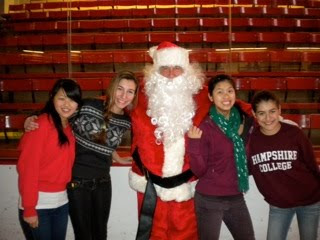
By Lilly
During the three-day weekend of Veterans Day, the Sprouts of Hope had the incredible opportunity to join in a day of activities and workshops with other groups at the Northeast Regional Roots & Shoots Youth Summit. In other years we’ve attended this magnificent event in Boston, but this time it was held in New York City, so we went to the city that never sleeps.
At the summit, the Sprouts of Hope presented a workshop about our book, "Energy Lite" and how it works in libraries for kids and families to borrow along with a Kill A Watt meter.
We began by introducing the members of our Roots & Shoots group — from left to right, Eliza, Lilly, Risa, Maya and Kaya.
Then we explained how we became interested in Kill-A-Watt meters and now they can measure the energy that our household appliances use. We told those who came to our workshop about our partnership with N-Star — when we tried out Smart Meters to measure energy use throughout our homes — and how they also gave us Kill-A-Watt meters to use.

Next, we explained how we put our book together — from coming up with ideas for what we’d write about to outlining it on index cards to writing its various sections. We shared the story of how we managed to get our book and Kill A Meters into public libraries in Cambridge, Boston, Medford, MA and Central Falls, Rhode Island; this is which is an ongoing project of ours and we are going to raise by crowdfunding online so we can get our book and a meter into all of the 370 public libraries in Massachusetts.

We used Kill-A-Watt meters to show how much energy three different light bulbs use — incandescent (they use the most), CFLs (less than incandescent) and LEDs (that use a lot less than even CFLs). We also showed how much energy a hairdryer uses. The answer: a lot, especially when turned on high — so try to let your hair dry naturally.
In our presentations about “Energy Lite,” we share information about energy use — and how to conserve use of it, but we also want to pass along a message that can help kids to make their ideas turn into real projects that make a difference in other people's lives. So we pass along our motto of the 3P’s — Partners, Patience and Persistence. These are the three things we keep in mind as we work to make our projects successful.
We told those who came to our workshop about our partners — our local utility, NStar, P3, the company that makes Kill A Watt meters and donated 20 of their meters to the Cambridge Public Library when we gave the library our book, and Shonak Patal, who created a local website called Swellr and came to talk with us about crowdfunding our project. We are grateful to all of them for their support and encouragement.
Our experience in working with our local library spoke to the value of partnerships in making big projects happen and about the patience and persistence that will be required of us as we try to raise money in the spring to make “Energy Lite” and Kill A Watt Meters an item that families can borrow from their local libraries across our state.

We hope people left our workshop with a better idea of how to take action. Those who came to it were very enthusiastic in what we are doing and showed a lot of interest in our book. One teacher took a copy to put into the library at her school, and two New Yorkers expressed an interest in getting our book into New York public libraries. Overall, we thought the workshop went very well and it was a great experience.








































 We listened as Cecilia Ibeabuchi, who works at the BHCHP clinic as a nurse, explained that homeless people aren’t allowed to take their socks off in shelters in order to prevent infections and bad smells. But this means that homeless people’s socks get really dirty. Often, this means they have to use plastic shopping bags as socks.
We listened as Cecilia Ibeabuchi, who works at the BHCHP clinic as a nurse, explained that homeless people aren’t allowed to take their socks off in shelters in order to prevent infections and bad smells. But this means that homeless people’s socks get really dirty. Often, this means they have to use plastic shopping bags as socks.




